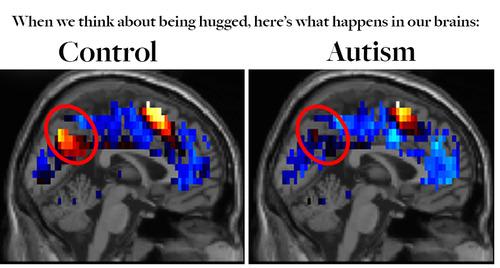Seeing How The Brain Responds To Hugs Could Lead To Better Autism Diagnosis
by Jennifer Gerson Uffalussy December 2, 2014

Thanks to new research, we may be able to see autism in the same way we see a broken ankle on an X-ray. (Photo by Getty Images)
Psychiatric disorders – including autism – are currently diagnosed based on a clinical behavioral assessment, a process that’s highly nuanced and highly subjective.
To assess for autism in toddlers include, parents are asked: “If you point at something across the room, does your child look at it,” and “does your child play pretend or make-believe?” Anyone with a young child knows that these types of general questions are very difficult to conclusively answer.
But now, Carnegie Mellow University researchers have created a potentially decisive way to diagnose autism— and other psychiatric disorders — with 97 percent accuracy: By examining how our brains respond to the thought of a hug.
It’s common knowledge that people with autism act differently in social interactions than those without. Their ability to tune in to the thoughts and feelings of others does not develop in the same way as their neurotypical peers. “This means there is something different in their thought processes,” says lead researcher Marcel Just, D. O. Hebb Professor of Psychology at Carnegie Mellon University. ”So we know the difference has to be in the brain.”
Just and his team discovered the exact part of the brain — and thus, the area of thought creation — in which those with autism process information differently. And this difference can be seen on a simple brain scan.

These brain images illustrate how the brain representations of a social interaction, “to hug” in this example, differ between neurotypical and autistic participants. The image on the left shows the neural activation for “hug” in the control participants; the image on the right shows the autism group’s near absence of activation in the brain’s posterior midline region – an area which contributes to the representation of the “self.” Although these images show the group average activation patterns, the brain representations of the social interactions in individual participants were sufficiently distinctive to allow participants to be identified as belonging to the autism or control group with 97% accuracy.” (Image courtesy of Carnegie Mellon University)
Just’s research was published on December 2, 2014, in the journal Plos One. In the study, 34 subjects – 17 high-functioning autistic adults and 17 neurotypical adults — were given fMRI brain scans while being asked to think about sixteen different words describing varying social interactions, such as “hug,” “compliment,” “kick” and “insult.”
Whereas the control subjects showed activity in the part of the brain associated with self-representation, the subjects with autism did not. This means that the autistic individuals envisioned the words and actions being told to them without themselves as a participant in defining the scenario, while the control group saw themselves being hugged, complimented, kicked, and insulted when thinking about these concepts.
Related: 5 Medical Procedures You May Not Actually Need
Furthermore, Just and his team identified that the more a subject’s self-representation is altered, the worse they are at facial recognition-based tasks, the hallmark of autism diagnosis and one of the primary indicators for an autistic individual’s placement on the autism spectrum. (The more facial recognition an individual can complete, the higher functionality they exhibit on the spectrum.)
“It is so hard to characterize psychiatric illness. Sometimes it’s easy to pinpoint, but sometimes it’s not so easy to characterize the alteration that makes the person with a certain disorder process their world differently and thus behave differently,” Just told Yahoo Health, adding that this discovery of a thought marker breaks new ground in showing a biological basis in thought alteration.
Though Just says he himself is not sure what new therapies could be developed around helping those with this disorder of self-representation, he makes an important point about how his research can aid our societal understanding of autistic individuals: “People with autism come off as different and strange and sometimes frightening. This finding shows a biological basis for it. It frames this behavior in terms of understandable, biological alterations versus a not understandable, almost mystical force.”
Now we can see autism, and potentially other psychiatric disorders, in the same way we see a broken ankle on an X-ray. Something previously inaccessible and confusing is now that much more knowable.
The research being done by Just and his peers allows an alternate route to diagnosis that is based in objective data — as opposed to repeated behavioral analysis — potentially allowing for a whole new contextualization and conversation around not only the diagnosis of autism, but of all psychiatric disorders.
Find the article HERE






